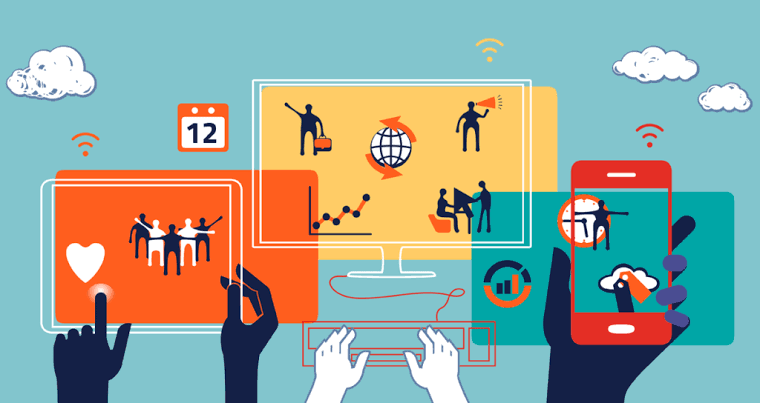What is Digital Information Technology: A Primer

As you navigate the increasingly digital world, it is important to understand some basics about the technologies that power it. Digital information technology refers to the broad infrastructure enabling the creation, storage, exchange, and consumption of digital data and content. From the devices we use to access information to the networks that connect us and the platforms on which we interact, digital technology has transformed how we live and work.
While these technologies may seem complex, they are built on a few fundamental concepts. Understanding these core ideas will allow you to better leverage technology to improve your productivity, connect with others, and stay informed. In this primer, we will explore some of the essential components of the digital ecosystem, including hardware, software, networks, and services. We will also discuss current trends that are shaping the future of how we create and share information. By developing a foundational knowledge of these building blocks, you will be better equipped to thrive in today’s digital world.
What is Digital Information Technology?
Digital Information Technology Class
The Fundamentals
To understand digital information technology, you must first comprehend some key concepts. Digital information is any data that is stored in digital, as opposed to analog, form. This includes text, numbers, images, audio, and video in a format that can be read and manipulated by a computer.
Digital information technology refers to the tools and systems used to store, retrieve, manipulate, transmit, and receive digital information. This includes both physical hardware like computers, storage drivers, networking equipment and the software that runs on them.
Hardware Components
The core components of digital information technology hardware are:
- Computer – Desktop PCs, laptops, tablets, and smartphones are all capable of processing and storing digital information.
- Storage – Hard drives, solid-state drives, optical media like CDs and DVDs, flash drives, and memory cards are used to store digital information persistently.
- Networking equipment (routers, switches, modems, and wireless access points) facilitates the transmission of digital information between devices and across networks like the Internet.
- Input/output devices – Keyboards, mice, touchscreens, microphones, and digital cameras are used to input digital information into a system. Monitors, printers, and speakers output the information
Key Concepts
To utilize digital information technology effectively, you must understand some fundamental concepts, like:
- Bits and bytes: The binary digits 0 and 1 are used to represent all digital information. 8 bits make up 1 byte.
- Compression: Techniques like MP3 and JPG are used to reduce the size of digital files for storage and transmission.
- Encryption: Methods such as HTTPS and Wi-Fi encryption are used to protect digital information from unauthorized access.
- Protocols: Standards like HTTP, FTP, and TCP/IP allow different digital systems to communicate and exchange information.
With a firm grasp of these hardware components, concepts, and standards, you will have a solid foundation in digital information technology. Continuously keeping your knowledge up-to-date as technologies evolve is key.
The Importance of Digital Information Technology in Today’s World

Digital information technology plays an integral role in both our personal and professional lives today. As society becomes increasingly connected, our dependence on technology continues to grow.
Access to Information
With the Internet, we have access to vast amounts of information on any topic at our fingertips. This access to knowledge and resources has many benefits, including:
- The ability to research and learn new skills through online tutorials, courses, and videos.
- The opportunity to connect with subject-matter experts and colleagues around the world.
- Increased productivity and efficiency. Many tasks that once required a trip to the library or office can now be accomplished online, saving time and money.
Global Connectivity
Modern technologies like social media, email, video conferencing, and instant messaging have the ability to connect with people all over the world. Some of the major benefits of increased global connectivity include:
- Enhanced communication with friends and family across the globe. It is now easy to stay in touch via services like Facebook, WhatsApp, and Skype.
- Improved international business relationships. Technologies like video conferencing allow people from different countries and time zones to meet face-to-face without the time and expense of travel
- Exposure to new cultures and diversity of thought. By connecting with people from different backgrounds and experiences, we can gain new perspectives and become more open-minded and empathetic.
In today’s digital world, information technology plays a crucial role in how we live, work, learn, and connect as a global society. While technology will continue to shape our future in new ways, embracing it in a balanced and purposeful manner can lead to many benefits. Overall, digital information technology has enormous potential to improve lives if used responsibly.
Key Components of DigitalInformation Systems
Digital information systems rely on three key components to function: hardware, software, and network infrastructure.
Hardware
The physical components of an information system include input/output devices, processors, storage media, and more. Hardware provides the physical platform to run software and store data. Examples include:
- Personal computers, tablets, and smartphones
- Scanners and printers
- Servers
- Hard drives, USB drives, and cloud storage
Software
The programs and applications run on hardware and allow users to perform tasks like word processing, web browsing, and data analysis. The software directs the hardware components and allows them to function. Common examples include:
- Operating systems like Windows, macOS, and Linux
- Productivity software such as Microsoft Office and Google Workspace
- Specialized programs for tasks like photo/video editing, accounting, and more
Network Infrastructure
The resources that connect hardware and software components and allow them to communicate include:
- Wired and wireless networks
- Network devices like routers, switches, and access points
- Network protocols and standards such as Ethernet, Wi-Fi, TCP/IP, and HTTP
- Network connectivity, such as broadband and cellular data
With continued advancement, these three pillars of digital information technology will enable more powerful, integrated, and automated information systems. Understanding how they interact and support each other is key to leveraging technology effectively and securing information systems.
Digital Information Technology Skills Everyone Should Learn
Digital information technology has transformed how we live and work. To thrive in today’s world, there are a few essential skills everyone should learn.
Coding
Learning to code teaches you how to think logically and solve complex problems. Even basic knowledge of HTML, CSS, and JavaScript can help you build simple websites and automate routine tasks. Many free resources are available to learn coding at your own pace.
Data Analysis
With the rise of big data, the ability to analyze and interpret data is an invaluable skill. Learn how to uncover insights and trends using tools like Excel, SQL, Python, and Tableau. Strong data analysis skills are useful for marketers, researchers, and business leaders.
Digital Marketing
Digital marketing encompasses social media, content creation, search engine optimization, and more. Develop a working knowledge of how to build an online presence, engage an audience, and drive business through digital channels. Useful for entrepreneurs, bloggers, and marketing professionals.
Productivity Tools
Master the basics of workplace tools like Google’s G Suite, MS Office, project management platforms, and communication apps. Learn keyboard shortcuts, automation techniques, and how to optimize these technologies to improve productivity and collaboration.
Online Research
Knowing how to quickly find reliable information on the Internet is essential for work study, and life. Practice advanced searching techniques, fact-checking skills, and how to identify high-quality, credible sources. Strong online research abilities will benefit anyone in business, education, healthcare, and beyond.
Gaining proficiency in these digital skills will prepare you for success in an increasingly tech-driven world. While the specific tools and platforms may change over time, the underlying technical and soft skills you develop will remain relevant for years to come.
The best digital information Technology course
1. Advanced Digital Marketing
2. Digital Product Management
3. Digital Marketing Strategy and Planning.
4. Digital Information Literacy
5. Information & Digital Literacy for University Success
6. Digitalization in International Relations
7. Digital Transformation
8. Digital Marketing Specialization
How to Get Started With a Career in Digital Information Technology
To start a career in digital information technology, here are some steps to get you started:
Learn In-Demand Skills
Develop expertise in areas like data analysis, cybersecurity, web development, and cloud computing. These disciplines are in high demand. You can take online courses to build up your knowledge in areas that interest you. Look for courses that teach skills that local employers are seeking.
Earn Relevant Certifications
Industry certifications validate your skills and expertise to employers. Some recommended certifications for digital information technology include:
- CompTIA A+ for hardware and software
- Cisco Certified Network Associate (CCNA) for networking
- Certified Information Systems Security Professional (CISSP) for cybersecurity
- AWAS Certified Solutions Architect for cloud computing
Build your Experience
While certifications and education are important, most employers seek candidates with proven work experience. You can gain valuable experience through internships, apprenticeships, freelancing, and entry-level jobs. Work on building a portfolio of projects that showcase your abilities.
Network and Make Connections
Networking is key to finding new opportunities. Connect with professionals in the industry, join relevant online communities and social networks, and attend industry events. Let people know you’re on the job market and the type of position you’re seeking. Someone in your network may know of an opening and be able to refer you as a candidate.
Search and Apply for Jobs
Once you have the necessary skills, experience, and certifications, start applying for jobs in digital information technology. Search on sites like Indeed, Monster, and LinkedIn. Be prepared for technical interviews where you may be asked about your work experience, education, certification, technical skills, and career goals. With the right preparation, you can land an exciting new role in this fast-growing field.
Conclusion
As you understand, digital information technologies have transformed how we live, work, and play. Advancements in computing, networking, and software have enabled new capabilities and disrupted entire industries. While the pace of change can feel overwhelming, taking the time to develop a basic understanding of these foundational concepts will help you navigate this new digital world. With knowledge comes the power to use technology as a tool to improve lives and society. Though the future remains unclear, one thing is certain – digital technologies will continue to shape our shared human experience in profound and meaningful ways. Stay curious and keep learning. The digital future is ours to create.
FAQs







